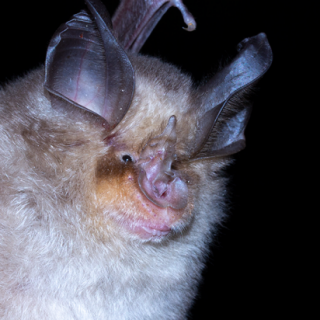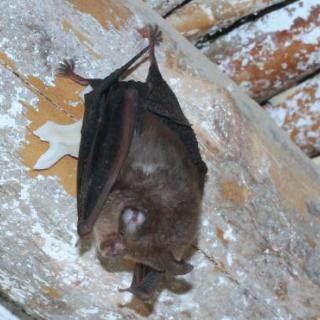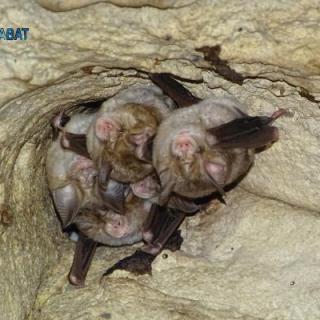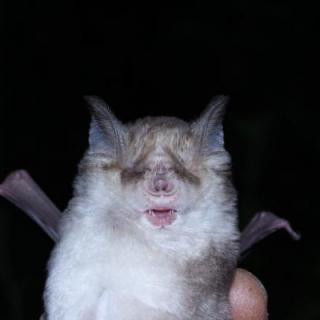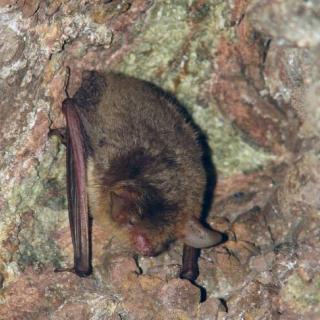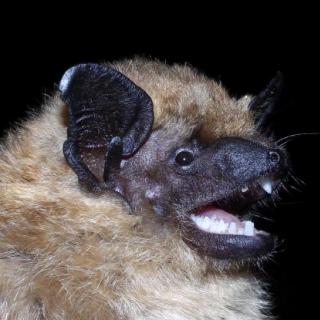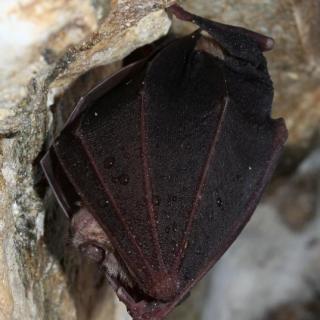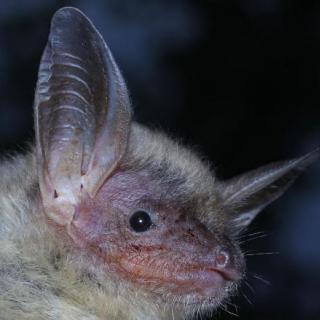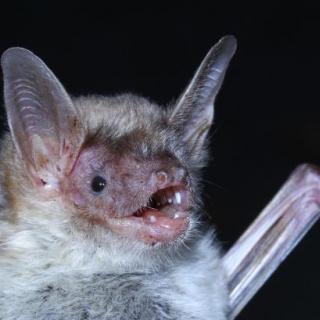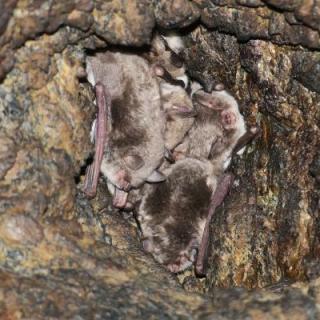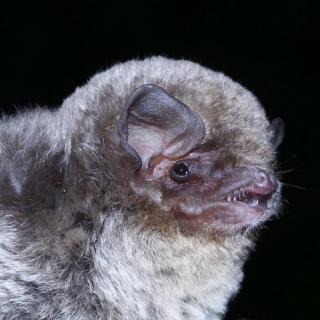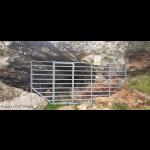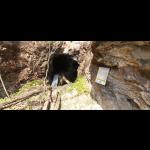LIFE GRECABAT aims (among others) to improve the conservation status of ten species of chiroptera which are classified in Annexes II and IV of Directive 92/43/EEC and form important colonies in caves and other types of roosts: Miniopterus schreibersii, Myotis blythii, M. capaccinii, M. emarginatus, M. myotis, Rhinolophus blasii, R. euryale, R. ferrumequinum, R. hipposideros and R. mehelyi.
In addition to these species, we provide information on two more, Eptesicus serotinus and Myotis nattereri (Annex IV of Directive 92/43/EEC), as they form unusually large colonies in two sites of the program, the two Panagopoula tunnels.
Mediterranean horseshoe bat
-
Rhinolophus euryale, Blasius,1853
It is a medium-sized bat, smaller than the similar Rhinolophus mehelyi, with wingspan up to 32 cm and weight from 9 to 14 grams. The fur of the back is brownish-gray or brownish red and usually differs slightly from the grayish (sometimes whitish) abdominal hair. Its eyes are slightly hidden behind the horseshoe, while the upper protrusion of the saddle is pointed and slightly curved downwards. At the fourth finger the first phalanx is less than half as long as the second, in contrast to the similar Rhinolophus blasii.
Lesser Horseshoe Bat
-
Rhinolophus hipposideros, (Bechstein, 1800)
It is one of the smallest bats in Europe and the smallest of the family Rhinolophidae with wingspan up to 25 cm and weight from 4 to 7 grams. The fur on the back is brownish-gray or brownish-yellow, while on the abdomen it is white-gray. The upper protrusion of the saddle is shorter than the lower.
Blasius's horseshoe bat
-
Rhinolophus blasii, (Peters, 1866)
It is a medium-sized bat with a wingspan of up to 28 cm and weight of 10 to 14 grams. The fur on its back is pale brown or yellowish with a whitish base, while on the abdomen it is slightly pale. Both saddle protrusions are sharp, and only in some individuals of this species the skin fold under the blade has a groove in the middle. At the fourth finger the first phalanx is more than half the length of the second, unlike Rhinolophus euryale and R. mehelyi where the first phalanx is less than half the length of the second.
Mehely's Horseshoe Bat
-
Rhinolophus mehelyi, Matchie, 1901
It is a medium-sized bat, slightly larger than Rhinolophus euryale and smaller than R. ferrumequinum, with wingspan up to 34 cm and weight ranging from 10 to 18 grams. The belly and face hair is pale (almost white), while the back is gray-brown. Most adult people have dark hair around their eyes, like a "mask", which is sometimes seen in other species. The upper protrusion of the saddle is slightly rounded, whereas only in this species the blade narrows sharply from the middle to the edge.
Natterer's bat
-
Myotis nattereri (Kuhl, 1817)
It is a small bat with a wingspan of 24-30 cm and a weight of 7-10 grams. The white gray belly fur is clearly delimited from the brownish-gray fur on the back. The tragus curves slightly forward and is longer than half the length of the ear.
Serotine bat
-
Eptesicus serotinus (Schreber, 1774)
It is a large bat with a wingspan of 31 to 38 cm and a weight ranging from 18 to 25 grams. It has medium sized ears with a rounded edge. The back hair is dark to reddish brown, while the belly is lighter to yellowish brown. The face, ears and wings are dark brown.
Greater horseshoe bat
-
Rhinolophus ferrumequinum, (Schreber, 1774)
It is a large bat (the largest of the family Rhinolophidae) with a wingspan of up to 40 cm and a weight ranging from 18 to 24 grams. The fur on the back is brown or brownish-gray, often with reddish edges. The abdomen is white - gray to white - yellow. The upper projection of the saddle is round at the edge, while the bottom is short.
Greater mouse-eared bat
-
Myotis myotis, Borkhausen, 1797
It is one of the largest bats in Greece weighting 20-27 grams and having a wingspan of 35-45 cm. It has large ears and wide nose. Its fur is brown or reddish brown on the back and distinctly off-white on the belly. It is morphologically similar to Myotis blythii, but slightly larger in size, with a longer jaw length (the basic diagnostic character) and yellow toned neck, while at the end of the tragus many individuals present a small black dot.
Geoffroy's bat
-
Myotis emarginatus, (E. Geoffroy Saint-Hilaire, 1806)
Myotis emarginatus is a relatively small bat, with 6-9 grams weight and wingspan between 22 and 25 cm. The long hair gives the impression that it is 'disheveled' and is typically reddish on the back and yellowish-brown on the belly. Its ears have a notch, forming an almost right angle to their outer border and the lobe is granular. Compared to the similar M. nattereri, the spur is straight and shorter and the tip of the uropatagium is covered by short soft hairs.
Lesser Mouse-eared Myotis
-
Myotis blythii, Tomes, 1857
The Lesser mouse-eared bat is a medium-sized bat with quite large ears. It is morphologically similar but smaller than M. myotis. The nose and ears are also shorter and narrower, but the distinction from M. Myotis is extremely difficult. The wingspan varies from 30 to 40 cm and the weight from 19 to 26 grams. The fur on the back is brownish-gray and the abdomen distinctly off-white. Often the fur between the ears has a pale spot.
Long-fingered Bat
-
Myotis capaccinii, Bonaparte, 1837
It is a small bat with a wingspan of 23 to 26 cm and a weight of 7-10 grams. Its fur is gray with a brown tint on the back and whitish grey on the belly. It has characteristically large and strong feet (over half of the tibia) with long hairs. The tragus is slightly S-shaped which allows it to be easily distinguished from the similar species Myotis daubentonii.
Common bent-wing bat
-
Miniopterus schreibersi (Kuhl, 1817)
It is a relatively small species with wingspan 30 to 34 cm and weight between 9 and 16 grams. It has short, square ears and a very small round tragus. The forehead is domed and its hair stand almost upright. The wings are narrow and long. The fur of the back is grayish-brown, while the belly is lighter in color.



